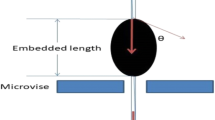Abstract
Single-fibre pull-out experiments were carried out on samples which had been immersed in water at 22°C, 60°C and 75°C for periods of up to 13 000 h. A curve-fitting technique was used to estimate the pressure and coefficient of friction during sliding, as the fibre was pulled out of the polymer. The immersion reduced the pressure from about 16 M Pa to about 6 M Pa for immersion at 75°C. The effect was much smaller at 60°C and still less at 22°C. The results indicated that, except at 75°C, the pressures were governed by the thermal and chemical shrinkages, water dilation of the polymer, and the change in Young's modulus of the polymer caused by the water. At 75°C the apparent thermal shrinkage stress was anomalously low, taking into account the dilatation and plasticization of the resin. This could have been due to some slight dissolution of the glass by the water. The coefficient of friction was reduced, possibly by softening of the interphasial material when silanes were present. When the silane coating was removed the friction did not appear to obey Amontons law and it was concluded that a water film was probably present at the interface.
Similar content being viewed by others
References
M. R. Piggott,J. Mater. Sci. 13 (1978) 1709.
C. C. Chamis, in “Proceedings of 2nd International Conference on Composite Materials” (Met. Sue. AIME, 1978) p. 221.
M. R. Piggott, in “Proceedings of 5th International Conference on Fracture” (Pergamon, 1981) pp. 465–72.
Idem., US Pat. no. 4427735, 1984.
J. T. Lim, M. R. Piggott andW. J. Bailey,SAMPE Q.15(4) (1984) 25.
M. R. Piggott andP. S. Chua,Ind Eng Chem. Product RID 26 (1986) 672.
P. S. Chua andM. R. Piggott,J. Mater. Sci. 27 (1992) 913.
P. S. Chua, S. R. Dal andM. R. Piggott,ibid.27 (1992) 919.
M. Reboredo andM. R. Piggott, in “Proceedings of 34th International SAMPE Symposium”, Re ho, Nevado, May 1989 (Society for the Advancement of Materials and Processing Engineering, California, 1989) p. 1913.
R. Juran (ed.), “Modern Plastics Encyclopedia” (McGraw Hill, New York, 1990) p. 508.
S. Timoshenko, “Strength of Materials”, Part II (Van Nostrand, New York, 1958) Ch. 6
Author information
Authors and Affiliations
Rights and permissions
About this article
Cite this article
Chug, P.S., Piggott, M.R. Mechanical properties of the glass fibre-polyester interphase. J Mater Sci 27, 925–929 (1992). https://doi.org/10.1007/BF01197643
Received:
Accepted:
Issue Date:
DOI: https://doi.org/10.1007/BF01197643




